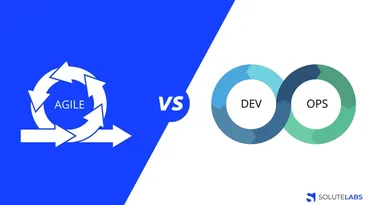Agile is a framework that emphasizes collaboration, flexibility, and iterative development. It is a proven methodology that has been used successfully by many organizations to transform their processes and workflows. However, implementing agile is not easy. It requires a significant shift in mindset, processes, and workflows. In this blog, we will explore the meaning of agile transformation, discuss the steps to a successful agile transformation, and provide a roadmap for implementing agile within your organization. So, whether you are a business owner, a project manager, or a team leader, this blog is for you. Let's get started!
What is Agile Transformation?
Agile transformation is a methodology that organizations use to adapt and respond to the rapidly changing business environment. It involves a shift from traditional, hierarchical management to a more collaborative and adaptive approach to project management. Agile transformation requires a significant change in mindset, processes, and workflows. This change enables organizations to become more agile and adaptable to changing market conditions, improve customer satisfaction, and increase productivity.
Explore: Agile Adoption and Development Trends for 2023
What is Agile Transformation Strategy?
Agile transformation strategy is a plan that outlines how an organization will adopt and implement agile methodologies in their workflows, processes, and culture.
An effective agile transformation strategy should be aligned with the organization's overall goals and objectives. It should also be tailored to the organization's unique needs, challenges, and opportunities. The strategy should provide a clear vision of what the organization wants to achieve with agile, including the benefits it hopes to realize, such as faster time to market, improved customer satisfaction, and increased productivity.
The strategy should also identify the key stakeholders who will be impacted by the agile transformation and involve them in the process. This includes executives, managers, team members, and customers. Engaging stakeholders early and frequently can help build buy-in, promote collaboration, and ensure that everyone is aligned with the vision and goals of the transformation.
In addition, the agile transformation strategy should outline the steps, milestones, and timelines for implementing agile. This includes identifying and prioritizing initiatives, building cross-functional teams, investing in agile training, starting with a pilot project, and measuring progress. The strategy should also provide a plan for communication, feedback, and continuous improvement.
Finally, a successful agile transformation strategy should foster a culture of collaboration, experimentation, and continuous learning. It should encourage teams to embrace change, take risks, and adapt to new circumstances quickly. This requires a shift in mindset from traditional, hierarchical structures to a more open, flexible, and innovative approach to problem-solving and decision-making.
Also, Read: How Agile and Outsourcing Can Be Better Together?
Steps to Successful Agile Transformation:
Here are some steps to follow for a successful agile transformation:
1. Develop a Vision for Agile Transformation:
Developing a clear and inspiring vision is a crucial first step in the agile transformation process. The vision should be aligned with the organization's goals and values, specific and measurable, and communicate the benefits of adopting agile methodologies. It is important to engage key stakeholders across the organization in the process to build buy-in and ensure everyone is aligned with the vision and goals of the transformation. Once the vision is developed, it should be communicated widely and frequently to team members through various channels and supported by training and development programs.
2. Build a Cross-Functional Team:
Building a cross-functional team is an essential component of a successful agile transformation. An agile cross-functional team is made up of individuals from different departments or areas of expertise who work together towards a common goal. These teams are self-organizing and have the autonomy to make decisions and prioritize work based on customer needs. Building a cross-functional team requires identifying the right individuals with the necessary skills and experience, ensuring clear roles and responsibilities, and fostering a culture of collaboration and transparency. The team should be empowered to experiment, innovate, and adapt to changing circumstances quickly. By bringing together diverse perspectives and skills, cross-functional teams can drive better outcomes and help organizations to become more agile, responsive, and customer-focused.
3. Invest in Agile Training:
Agile methodologies require a different way of working, and team members may need to develop new skills and mindsets to embrace these changes fully. Providing training and development opportunities can help team members to learn new ways of working, develop agile competencies, and build confidence in their ability to contribute to the transformation. Training can take many forms, from formal classroom-based courses to on-the-job coaching and mentoring. It is essential to tailor training to the needs of the team and provide ongoing support to reinforce learning and development.
4. Create a Culture of Collaboration:
Creating a culture of collaboration is crucial to support agile methodologies. It involves promoting transparency, trust, and open communication across the organization, encouraging cross-functional collaboration, and fostering shared ownership of work. Leaders play a critical role in modeling these behaviors and providing support and resources to enable collaboration. A collaborative culture supports agile principles and helps organizations become more resilient, innovative, and effective.
5. Implement Agile in Small Increments:
This approach involves breaking down the transformation process into manageable stages, focusing on delivering value to customers with each incremental change. This enables teams to learn and adapt as they go and reduces the risk of disruption to the organization. It also allows the organization to measure progress, identify areas for improvement, and make adjustments accordingly. By implementing agile in small increments, teams can build momentum, gain confidence, and demonstrate the value of the transformation to stakeholders.
6. Measure and Monitor Progress:
This involves defining metrics that align with the goals of the transformation, tracking progress regularly, and analyzing the results to identify areas for improvement. By measuring and monitoring progress, teams can identify potential issues early and make data-driven decisions to address them. It also helps to build transparency and accountability, ensuring that everyone is aligned with the goals of the transformation and contributing to its success.
7. Foster a Continuous Improvement Mindset:
This involves encouraging teams to reflect on their performance, identify areas for improvement, and experiment with new ways of working. By fostering a continuous improvement mindset, teams can drive innovation, learn from their mistakes, and continuously enhance their performance. It is also important to provide support and resources to enable continuous improvements, such as training, coaching, and access to tools and technology. By embracing a culture of continuous improvement, organizations can stay ahead of the curve, respond to changing customer needs, and remain competitive in a rapidly evolving market.
8. Embrace Change:
Embracing change is a fundamental aspect of agile transformation. Agile methodologies are designed to adapt to change, and teams must be prepared to embrace new ways of working and let go of old habits. This requires a mindset shift and a willingness to challenge the status quo, experiment with new ideas, and learn from failures. By embracing change, teams can become more agile, resilient, and customer-focused, and organizations can stay ahead of the competition and respond quickly to changing market demands.
Agile Transformation Roadmap
To implement a successful agile transformation, it is important to have a roadmap in place. The roadmap should include the following:
1. Assess the Current State of the Organization
Before embarking on the agile transformation, it is important to assess the current state of the organization. This will help to identify areas that need improvement and provide a baseline for measuring progress.
2. Define the Vision and Goals
The vision and goals for the agile transformation should be clearly defined. This will help to create a sense of purpose and direction for the transformation.
3. Develop a Plan for Implementation
The plan for implementation should include specific actions and timelines for the transformation. It should also include a plan for communication and stakeholder engagement.
4. Identify and Prioritize Initiatives
The initiatives that will support the agile transformation should be identified and prioritized. This will help to ensure that resources are allocated effectively.
5. Build the Agile Team
The agile team should be built with individuals from different departments and skill sets. The team should also include a mix of experienced and novice members.
6. Invest in Agile Training
Agile training should be provided to all team members. This will help to ensure that everyone understands the principles and practices of agile.
7. Start with a Pilot Project
The agile transformation should be started with a pilot project. This will help to test the new processes and workflows before they are implemented across the organization.
8. Review and Adjust the Plan
The plan for the agile transformation should be reviewed and adjusted regularly. This will help to ensure that the transformation is on track and that adjustments are made as needed.
9. Monitor Progress and Adjust as needed
Progress should be monitored regularly, and adjustments should be made as needed. This will help to ensure that the transformation is successful and that the organization is realizing the benefits of agile.
10. Celebrate Successes and Recognize Achievements
It is important to celebrate successes and recognize achievements throughout the agile transformation. This will help to create a positive culture and encourage continued improvement.
Also, Read: How to Execute Fixed-Cost Projects Using Agile Practices?
Conclusion:
Agile transformation is a significant undertaking for any organization. It requires a significant shift in mindset, processes, and workflows. However, with the right strategy, roadmap, and implementation plan, it is possible to lead a successful agile transformation.
Don't let your organization fall behind. Embrace agile methodologies with Agile Teams on Demand. Contact us today to learn how we can help your team stay competitive in a fast-paced, ever-changing market.
Have a product idea?
Talk to our experts to see how you can turn it
into an engaging, sustainable digital product.





